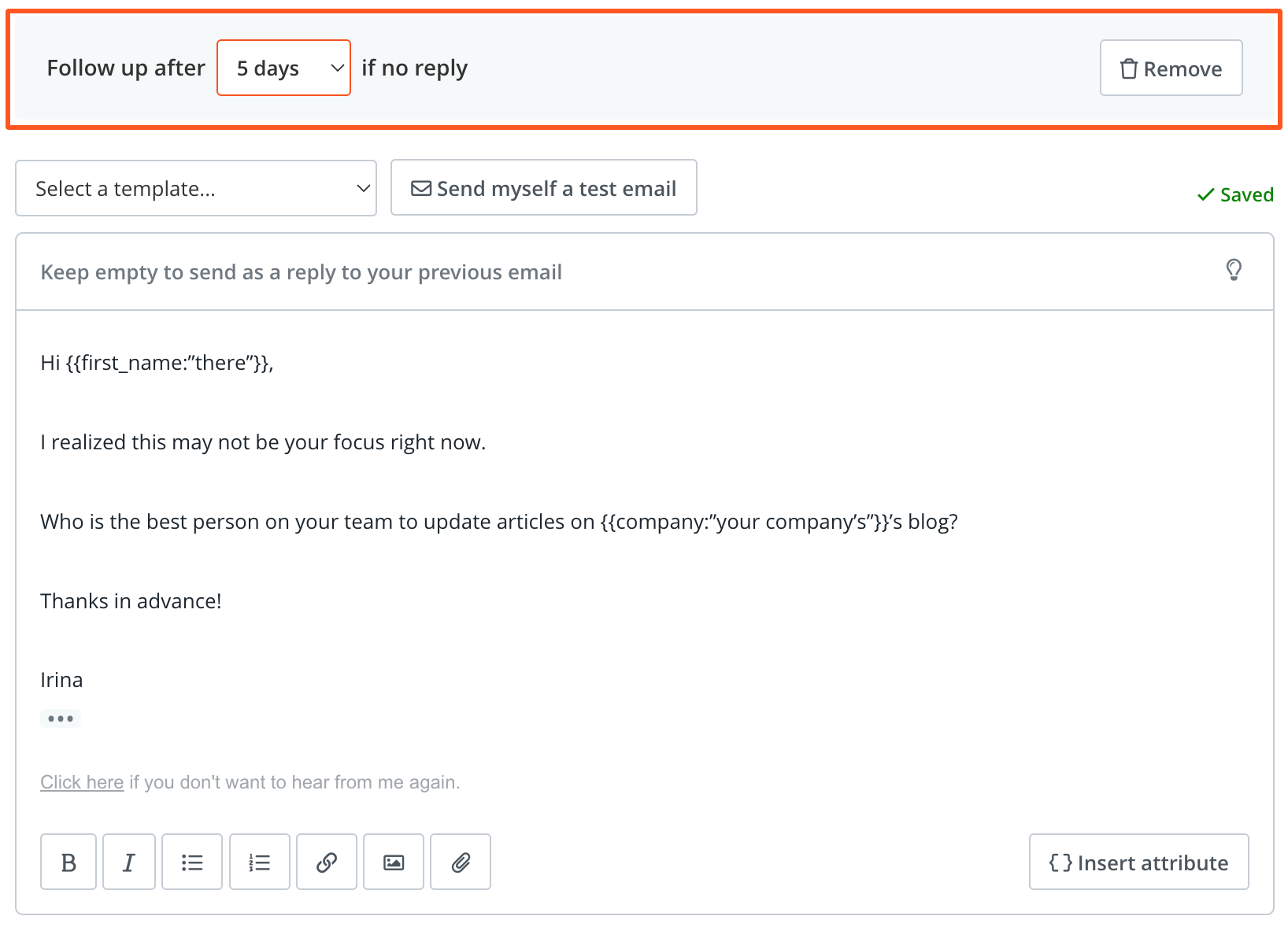How To Send a Follow-Up Email After No Response

1. Follow up in the same thread.
2. Wait 2-3 days at a minimum before you send a follow-up email.
3. Use a cold email tool to schedule your follow-ups in advance.
4. Write a follow-up email that adds value for the recipient.
5. Use a different CTA than in your first email.
Following up after you don’t get a reply to your email can significantly improve your reply rate.
The average reply rate for campaigns with follow-ups is 56% greater than for those without follow-ups.
In this article, I'll share some rules to follow when you're sending follow-up emails, and I'll also share examples of follow-up messages that perform well.
Follow up in the same thread
From a technical standpoint, there are two ways to send your follow-up message:
- You can reply in the same thread.
- You can send a brand new email to the same recipient.
In most cases, I recommend following up in the same thread.
Sending a new email has the benefit of letting you use a different subject line, and that may be enough to elicit a response in some cases.
But the trade-off is that your email will evoke some negative reactions for clogging up your recipients' inboxes.
Following up in the same thread lets the recipient easily refer to the content of your initial email to remember the full context of the conversation.
Wait 2-3 days before you follow up
You don’t need to wait too long before sending a follow-up email.
Most emails are opened the same day they’re received, so if you haven’t received a reply to your initial email within a day, it’s safe to assume you won’t receive a reply at all.
The conventional advice is to wait two to three days before sending your first follow-up. Give your prospect time to respond on their own terms. Remember that you should extend this wait time for every subsequent email you send to avoid annoying prospects.
Use a cold email tool to schedule your follow-ups
It can be hard to keep track of follow-ups if you're sending many outreach emails.
Tools like Hunter Campaigns can help you save time preparing and scheduling highly personalized cold email follow-ups.
Using Hunter, you can create email sequences that include follow-ups, and the tool will handle the sending of your emails at the right time. When someone replies to an email earlier in the sequence, they won't receive the follow-ups.
With Campaigns, you can choose how many follow-ups you want to send, specify the time delays between each follow-up, personalize the subject line, and work on the email copy.

Once you set this up, you’ll never have to worry about forgetting to follow up with your prospects. Your follow-ups will be sent automatically.
Write a follow-up email that adds value for the recipient
Following up for the sake of it won’t get you far.
“Nudge” emails only serve to annoy your prospects (and inflate your sending volume for no reason.)

When you write a follow-up email, consider the standpoint of your recipient:
- Have they opened your message?
- Were they convinced by the initial cold email?
A great follow-up takes all possible scenarios into account, which means it has two goals:
- It needs to simply pop up in your recipient’s mailbox, giving you another opportunity to make your pitch.
- It needs to present additional or alternative arguments that can convince the recipient to reply.
With each follow-up, you should provide additional value for the prospect.
Quite often, I receive follow-ups like this one:

Yes, I saw the first email, but the initial offer was unclear, and I didn’t know what Lauren wanted to achieve, so I decided not to reply.
If only she had provided more information with her follow-up, tried to collect more information about me (her prospect), and sparked interest with something relevant, I’d be happy to reply.
There are many opportunities to make follow-ups work by providing something of value.
For example, if you are a digital marketing agency, you can share success studies, results, or feedback to prove how your current clients are growing using your services.
When you have a small number of prospects, you can write each follow-up from scratch, making them unique and personal to each prospect.
A great example of such an email is the one I received from HubSpot’s Growth Manager after not talking to him for a month since our first conversation:

This email is great because it’s super personal. Adam did a lot of work by conducting such in-depth research. Besides including essential personalization, he made the follow-up effective by:
- Mentioning a mutual connection (he previously talked to our Customer Success Manager Giovanni).
- Providing a new offer relevant to our marketing strategy based on the information he previously received about putting our customer success project on hold.
- Showing his expertise (mentioned the companies he previously worked with).
- Ending with a clear CTA.
Use a different CTA than in your first email
When you send a follow-up to a cold prospect, you should be clear about what you want to achieve.
Just imagine you receive a similar follow-up to an email that you didn’t have an opportunity to open:

The first question you may ask yourself would be, “What does this person want from me?”. There is no context, no personalization, no call-to-action. Even if you read the context from the previous email, how do you know what you should do?
A call to action is very important when following up. If you don’t guide your prospect through the next steps, they are unlikely to take action.
At the same time, you shouldn't just restate the CTA you used in your initial message. If it didn't work the first time, now is your opportunity to try a different approach.
Many cold emails lack a call to action or have an ambiguous call to action that wastes the prospect's time. Make your call to action crystal clear, persuasive, and hard to resist. Tell your prospects what you want them to do.
Follow-up email examples
Need some inspiration for your next follow-up email? Check out these 7 follow-up email examples.
1. Your thoughts?
This is a very simple and polite follow-up email designed to keep you and your offer top-of-mind. It reminds the prospect of what you talked about and lets them know you’re available to answer any questions they might have.
2. Quick one {{first_name}}
Sometimes the best way to get a prospect to respond is to make them smile. This is exactly what this follow-up email tries to do.
3. Appropriate person
This follow-up email attempts to move the conversation forward by asking the prospect for their availability for a call. In case the prospect isn’t the right person you should be talking to, they can direct you to a colleague who’s a better fit to continue the conversation.
4. Not a priority?
With this email, you’re showing that you genuinely care about the prospect’s goals and won’t bother them if they don’t have an immediate need for what you’re offering. However, you’re still keeping the line open by letting them know that they can reach out to you at any time.
5. Ideas about [[lead’s goal or problem]]
Emailing multiple times and simply asking if they read your previous email or have time for a call can annoy prospects. On the other hand, providing value in the form of educational resources in your follow-up message is a great way to follow up with a prospect.
6. Better fit
If a prospect hasn’t replied to multiple follow-ups, it’s a good idea to check if there’s someone else on their team you should contact instead.
7. Permission to close your file?
Fear of missing out can be a great motivator. With this follow-up email template, the idea is to try to get the prospect to respond by making them think your offer won’t be available to them anymore.
Looking for more follow-up email examples? Check out Hunter Templates.
Wrap up
It’s quite difficult to catch the attention of someone who previously didn’t respond to you.
That’s why, while composing your follow-ups, make your primary focus on delivering value and providing irresistible offers instead of bombarding your prospects with too many follow-ups.
Write a catchy opening line to make your prospects read your message. Keep the email short to avoid losing their attention, and do your research to personalize follow-ups.
By following these simple tips, I'm confident that you’ll be able to get a reply from your prospects.




 Send cold emails with Hunter
Send cold emails with Hunter